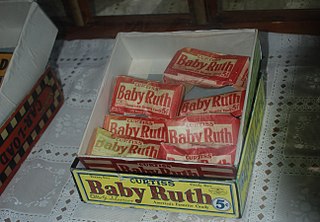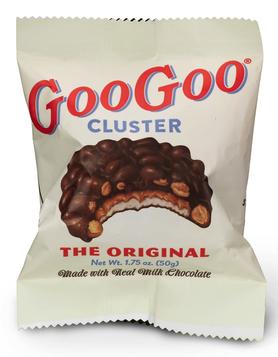
A chocolate bar or candy bar is a confection containing chocolate, which may also contain layerings or mixtures that include nuts, fruit, caramel, nougat, and wafers. A flat, easily breakable, chocolate bar is also called a tablet. In some varieties of English and food labeling standards, the term chocolate bar is reserved for bars of solid chocolate, with candy bar used for products with additional ingredients.

The Curtiss Candy Company is a defunct American confectionery brand and a former company based in Chicago, Illinois. It was founded in 1916 by Otto Schnering near Chicago, Illinois. Wanting a more "American-sounding" name, Schnering named his company using his mother's maiden name.

Reese's Peanut Butter Cups are an American candy by The Hershey Company consisting of a peanut butter cup encased in chocolate. They were created on November 15, 1928, by H. B. Reese, a former dairy farmer and shipping foreman for Milton S. Hershey. Reese left his job with Hershey to start his own candy business. Reese's are the top-selling candy brand worldwide, with more than $2 billion in annual sales generated for The Hershey Company.

Treets were a brand of confectionery sold by Mars Limited in France, Germany, Belgium and the Netherlands.

Reese's Take 5 is a candy bar that was released by The Hershey Company in December 2004. The original name of the candy bar was TAKE5 but common usage among consumers added a space. In June 2019, when the candy bar became part of the Reese's family, the name was officially changed to Reese's Take 5.
Picnic is a brand of chocolate bar consisting of milk chocolate and peanuts, covering chewy nougat, caramel, biscuit and puffed rice. Picnic bars are lumpy in shape. It is sold in Australia, parts of Canada, New Zealand, New York City, San Francisco Bay Area, India, Ireland, Russia, Ukraine, South Africa, Ireland, Germany and the United Kingdom. The UK, German and Indian versions differ from the Australasian version in that they also contain raisins.

Sky Bar is an American candy bar introduced by Necco in 1938, discontinued in 2018, and reintroduced in 2019 by the Sky Bar Confectionary Company. Each Sky Bar has four sections, each with a different filling—caramel, vanilla, peanut, and fudge—all covered in milk chocolate.

PayDay is a brand of a candy bar first introduced in 1932 by the Hollywood Candy Company. The original PayDay candy bar consists of salted peanuts rolled over a nougat-like sweet caramel center. Since 1996, classic PayDay candy bars without chocolate have been continually produced by The Hershey Company. In 2020, Hershey's released a "Chocolatey PayDay bar" as a permanent part of the PayDay product line; it is identical to the regular bar, but covered by a layer of chocolate.
Hershey's Snack Barz is the name of a brand of candy bar produced, marketed, and sold by The Hershey Company.

Boyer Candy Company is an American candy company located in Altoona, Pennsylvania. The factory is located in the downtown district. Boyer Candy is privately owned by Consolidated Brands, which is owned by the Forgione family.

Crunchy Nut is a breakfast cereal made by Kellogg's with flakes of corn, honey, three types of sugar, and chopped peanuts. The product was created by Kellogg's employees at their Trafford Park factory in Greater Manchester and first introduced in 1980.
The Weaver Popcorn Company, based in Van Buren, Indiana, is one of the largest popcorn companies in the United States.
The Hollywood Candy Company, or Hollywood Brands, was an American confectionery company formed in Hollywood, Carver County, Minnesota, in 1912 by Frank Martoccio.

Bun Bars are a line of candy bars manufactured by Pearson's Candy Company of Saint Paul, Minnesota, and available in the United States. Despite the name, Bun Bars are not bars at all, but actually round and flat, containing a disc made of maple or vanilla-flavored creme, or caramel, coated in milk chocolate and topped with a roasted peanut-chocolate cluster.

Crunch is a chocolate bar made of milk chocolate and crisped rice. It is produced globally by Nestlé with the exception of the United States, where it is produced under license by the Ferrara Candy Company, a subsidiary of Ferrero.

A candy bar is a type of candy that is in the shape of a bar. The most common type of candy bar is the chocolate bar, including both bars made of solid chocolate and combination candy bars, which are candy bars that combine chocolate with other ingredients, such as nuts, caramel, nougat, or wafers.














